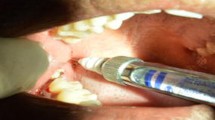Abstract
Introduction
The Gow-Gates technique is a useful alternative to the inferior alveolar nerve block whenever the latter fails to provide adequate anesthesia. The main disadvantage of this technique is that the incidence of unsuccessful anesthesia may be as high as that for the inferior alveolar nerve block until the administrator gains clinical experience with it.
Objectives
The aim of this study was to develop a device that facilitates the Gow-Gates technique and to increase its success rate even for administrators who are unfamiliar with this procedure.
Materials and methods
Ninety patients participated in our study. Forty-five patients received Gow-Gates mandibular block with device, and 45 patients received it without instrument (control group). Ninety 5th-year dental students who had no previous clinical experience with the Gow-Gates technique injected the patients.
Results and discussion
The success rate of anesthesia of inferior alveolar nerve, lingual nerve, buccal nerve, and auriculotemporal nerve were 93.3%, 93.3%, 91.1%, and 91.1%, respectively, in the study group and 68.9%, 68.2%, 68.9%, and 68.2%, respectively, in the control group.
Conclusion
We concluded that our device facilitates the Gow-Gates technique and increases its success rate irrespective of the gender of the patient, the side of the mandible being injected, and the experience of the administrator who uses the instrument.



Similar content being viewed by others
References
Bolding SL, Hutchins B (1987) Accessory innervation of the mandibular dentition in the cat. J Dent Res 66:157, Abstract 402
Brodsky CD, Dower JS Jr (2001) Middle ear problems after a Gow-Gates injection. J Am Dent Assoc 132:1420–1423
Childers M, Reader A, Nist R, Beck M, Meyers WJ (1996) The anesthetic efficacy of the periodontal ligament injection after an inferior alveolar nerve block. J Endod 22:317–320
Clark S, Reader A, Beck M, Meyers WJ (1999) Anesthetic efficacy of the myelohyoid nerve block and combination inferior alveolar nerve block/myelohyoid nerve block. Oral Surg Oral Med Oral Pathol Oral Radiol Endod 87:557–563
Dunbar D, Reader A, Nist R, Beck M, Meyers WJ (1996) Anesthetic efficacy of the intraosseous injection after an inferior alveolar nerve block. J Endod 22:481–486
Fish LR, McIntire DN, Johnson L (1989) Temporary paralysis of cranial nerves III, IV and VI after a Gow-Gates injection. J Am Dent Assoc 119:127–130
Frommer J, Mele FA, Monroe CW (1972) The possible role of the myelohyoid nerve in mandibular posterior tooth sensation. J Am Dent Assoc 85:113–117
Gow-Gates G, Watson JE (1989) Gow-Gates mandibular block—applied anatomy and histology. Anesth Prog 36:192–200
Gow-Gates G (1973) Mandibular conduction anesthesia: a new technique using extraoral landmarks. Oral Surg Oral Med Oral Pathol 36:321–377
Gustainis JF, Peterson LJ (1981) An alternative method of mandibular nerve block. J Am Dent Assoc 103:33–36
Heasman PA, Beynon ADG (1987) Quantitative and spectrum analysis of human myelohyoid nerve. J Anat 151:45–49
Jacobs S, Haas DA, Meechan JG, May S (2003) Injection pain: comparison of three mandibular blocktechniques and modulation by nitrous oxide:oxygen. J Am Dent Assoc 134:869–876
Jofre J, Munzenmayer C (1998) Design and preliminary evaluation of an extraoral Gow-Gates guiding device. Oral Surg Oral Med Oral Pathol Oral Radiol Endod 85:661–664
Kafalias MC, Gow-Gates G, Saliba GJ (1987) The Gow-Gates technique for mandibular block anesthesia. Anesth Prog 34:142–149
Kaufman E, Weinstein P, Milligram P (1984) Difficulties in achieving local anesthesia. J Am Dent Assoc 108:205–208
Levy P (1981) An assessment of the Gow-Gates mandibular block for third molar surgery. J Am Dent Assoc 103:37–41
Malamed SF (1981) The Gow-Gates mandibular block; evaluation after 4,275 cases. Oral Surg Oral Med Oral Pathol 51:463–467
Malamed SF (2004) Techniques of mandibular anesthesia. Handbook of local anesthesia. Mosby, St Louis, pp 227–253
Munzenmayer C, Tima M (1989) La tecnica de Gow-Gates, una alternative para la tercera rama del Trigemino. Anuario Hospital las Higueras 6:96–97
Nist R, Reader A, Beck M, Meyers WJ (1992) An evaluation of the incisive nerve block and combination inferior alveolar and incisive nerve block in mandibular anesthesia. J Endod 18:455–459
Novitsky J (1938) Sensory nerves and anesthesia of the teeth and jaws. Mod Dent 5:5–10
Potocnik I, Bajrovic F (1999) Failure of inferior alveolar nerve block in endodontics. Endod dent Traumatol 15:247–251
Reitz J, Reader A, Nist R, Beck M, Meyers WJ (1998) Anesthetic efficacy of the intraosseous injection of 0.9 ml of 2% lidocaine (1:100,000 epinephrine) to augment an inferior alveolar nerve block. Oral Surg Oral Med Oral Pathol Oral Radiol Endod 86:516–523
Sicher H (1946) The anatomy of the mandibular anesthesia. J Am Dent Assoc 33:1541–1557
Sillanpaa M, Vuori V, Lehtinen R (1988) The myelohyoid nerve and mandibular anesthesia. Int J Oral Maxillofac Surg 17:206–207
Sisk AL (1985) Evaluation of the Gow-Gates mandibular block for oral surgery. Anesth Prog 32:143–146
Takasugi Y, Furuya H, Moriya K, Okamoto Y (2000) Clinical evaluation of inferior alveolar nerve block by injection into the pterygomandibular space anterior to the mandibular foramen. Anesth Prog 47:125–129
Watson JE, Gow-Gates G (1992) Incidence of positive aspiration in the Gow-Gates mandibular block. Anesthesia and Pain Control in Dentistry 1:73–76
Wilson S, Johns PI, Fuller PM (1984) Accessory innervation of mandibular anterior teeth in cats: a horseradish peroxidase study. Brain Res 298:392–396
Wilson S, Johns PI, Fuller PM (1984) The inferior alveolar and myelohyoid nerves: an anatomic study and relationship to local anesthesia of the anterior mandibular teeth. J Am Dent Assoc 108:350–352
Yamada A, Jastak JT (1981) Clinical evaluation of the Gow-Gates block in children. Anesth Prog 28:106–109
Author information
Authors and Affiliations
Corresponding author
Rights and permissions
About this article
Cite this article
Zandi, M., Seyedzadeh Sabounchi, S. Design and development of a device for facilitation of Gow-Gates mandibular block and evaluation of its efficacy. Oral Maxillofac Surg 12, 149–153 (2008). https://doi.org/10.1007/s10006-008-0126-4
Published:
Issue Date:
DOI: https://doi.org/10.1007/s10006-008-0126-4




